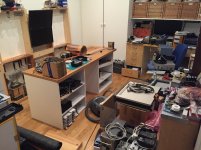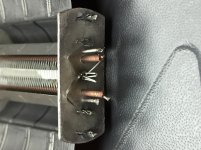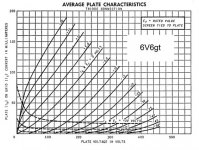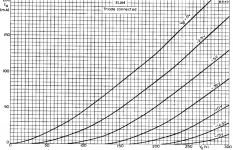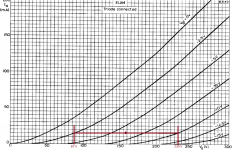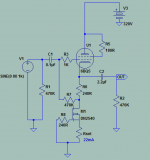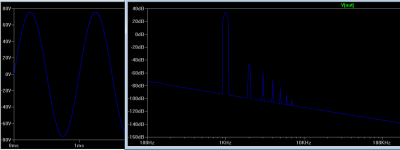Not much since I dont need it. My standard EL84pp with dynaco z565 irons clips at a little over consumer line level so Asio from a pro souncard keps me between 9 oclock ambient and 1-2 to high for neighbours.
Why not convert the test 6V6 pre to the cathode follower version then. Less rattles less Zo less THD.
Yea but I need to prio my projects. First in line is finishing the lab bench. Then proper boxing for the riaa and buffer. Then new strict poweramps. This play is just fun inbetween😉
Yes. You can also see how the suppressor grid g3 is interconnected with the cathode. But since its not heated up to the cathode level it doesnt emitt electrons but rather beams them in place. The rigidness and self resonance of this construction held in place by the micas and the glass is what sets the level of microphony.
Today I started on the EL84 comparison board. I also removed the output caps on the 12AU7/6922 preamp board and put in the same type of electrolytic used on the 6V6 board ( Panasonic 22uF 350V ).
The 6V6 board has been run in for many days. The cap on the 12AU7 board is new. It will have to run in for several days and all tests will have to be repeated !
I set the levels to be exactly the same ( within 0.1dB) for both preamps using an analog mV meter and a test signal CD. Both drove the same power amp. They were physically switched in and out. Test signal measured at the speaker terminals.
The 6V6 appeared to sound louder ! But also noisier !
The 12AU7 sounded smoother and HF seemed more revealing on 'some' tracks. The AU7 when played loud sounded fine. On the 6V6 I felt like turning the volume down. However in some sections the 6V6 seemed to be 'more dynamic' .....punchy !
I'm guessing the distortion components on the 6V6 are higher. But this is understandable as the 12AU7 has a cathode follower after the input tube and that will give the lowest distortion possible without feedback. I would guess that the 6V6 with a cathode follower might also sound better .
BUT, without comparisons, the 6V6 appears to sound fine !
The 12AU7 / 6922 ( EH tubes) are not microphonic even when physically tapped ! That was an interesting find. Earlier I never tapped tubes to see if they were microphonic !
Since the EL84 board is almost ready,I thought I'll go through the process and test that also. Obviously the next important test is to add a follower to the 6V6 ! Wonder if both will then sound identical or the 6V6 will better the 12AU7.
Maybe 6V6 gain stage with 6SN7 cathode follower ? So we will have 3 tubes.
That will also bring up the question of how the 6SN7 sounds in comparison ? 🙂 Anyone having a flexible setup to run these tests quickly ? 🙂
The 6V6 board has been run in for many days. The cap on the 12AU7 board is new. It will have to run in for several days and all tests will have to be repeated !
I set the levels to be exactly the same ( within 0.1dB) for both preamps using an analog mV meter and a test signal CD. Both drove the same power amp. They were physically switched in and out. Test signal measured at the speaker terminals.
The 6V6 appeared to sound louder ! But also noisier !
The 12AU7 sounded smoother and HF seemed more revealing on 'some' tracks. The AU7 when played loud sounded fine. On the 6V6 I felt like turning the volume down. However in some sections the 6V6 seemed to be 'more dynamic' .....punchy !
I'm guessing the distortion components on the 6V6 are higher. But this is understandable as the 12AU7 has a cathode follower after the input tube and that will give the lowest distortion possible without feedback. I would guess that the 6V6 with a cathode follower might also sound better .
BUT, without comparisons, the 6V6 appears to sound fine !
The 12AU7 / 6922 ( EH tubes) are not microphonic even when physically tapped ! That was an interesting find. Earlier I never tapped tubes to see if they were microphonic !
Since the EL84 board is almost ready,I thought I'll go through the process and test that also. Obviously the next important test is to add a follower to the 6V6 ! Wonder if both will then sound identical or the 6V6 will better the 12AU7.
Maybe 6V6 gain stage with 6SN7 cathode follower ? So we will have 3 tubes.
That will also bring up the question of how the 6SN7 sounds in comparison ? 🙂 Anyone having a flexible setup to run these tests quickly ? 🙂
6SN7 and a trioded EL84 could be compared since their amplification factor is in the hoods (18/20) but since the currents and loadlines are so different it would more be a comparision between two different rigs then two tubes.
I'm guessing the distortion components on the 6V6 are higher. But this is understandable as the 12AU7 has a cathode follower after the input tube and that will give the lowest distortion possible without feedback. I would guess that the 6V6 with a cathode follower might also sound better .
BUT, without comparisons, the 6V6 appears to sound fine !
The 12AU7 / 6922 ( EH tubes) are not microphonic even when physically tapped ! That was an interesting find. Earlier I never tapped tubes to see if they were microphonic !
Since the EL84 board is almost ready,I thought I'll go through the process and test that also. Obviously the next important test is to add a follower to the 6V6 ! Wonder if both will then sound identical or the 6V6 will better the 12AU7.
Maybe 6V6 gain stage with 6SN7 cathode follower ? So we will have 3 tubes.
That will also bring up the question of how the 6SN7 sounds in comparison ? 🙂 Anyone having a flexible setup to run these tests quickly ? 🙂
Ashok, some comments:
Adding a buffer to a gain stage will not bring down distorsion without adding global feedback over those, but then you also lower gain and add other troubles. Adding a buffer lowers z out.
The 6v6 gain stage has, implemented according to Salas drawing very low distorsion in the thermionic part. Microphonic feedback and distorsion from other comps like electrolyts might add to it though.
A cathode follower has low distorsion but dependent on two things: high mu to maximise the distorsion reducing component which is the internal feedback and a gm that is constant with current. Preferably a constant current source of some kind on the cathode. Large resistor, big choke, tube CCS or some chisel.
Correct me if I am wrong. The distortion on the first stage depends on load impedance. Lower Z load then higher distortion. Lets say the typical load is 20 K ohm ( what I use ) ! With a Cathode follower the load on the first stage is very high ( say 1 M ohm ! ) , so the load is 50 times higher (Z ohms) and hence distortion is lower. It isn't anything to do with any kind of feedback , just the basic behaviour of the gain stage. The CF will also have some additional distortion but that is minimal.
@ashok
If you use the cathode bypass capacitor the Zo of the common cathode circuit is 1.1K and will drive 20K. Its 4K Zo if non bypassed and it will not drive the 20K amp well.
If you use the cathode bypass capacitor the Zo of the common cathode circuit is 1.1K and will drive 20K. Its 4K Zo if non bypassed and it will not drive the 20K amp well.
Salas, how large would a triode bootstrapoed EL84 CF with a stiff CCS on the cathode swing without terrible distorsion?
With your 320V B+, 240R between cathode and heatsinked DN2540 @ 22mA CCS, 470K bootstrap from drain to the grid, it can do 150Vpp output with 160Vpp capacitor coupled input before high distortion
Ok you putted yourself a bit higher in current but otherwise fairly similar figures. Still it cant swing that much in cathode follower mode that I had hoped for. Maybe 8-9 Vpp compared to what a common cathode 6V6 line amp might spit out if you have a low sensitivity low z in poweramp. Thanks.
Where is that output swing? Its a CF. It gets fed back right? The whole tube swings that. I just wonder what the sim measures.
Last edited:
Its an input bootstrapped CF with stiff CCS. The drop across R6 biases the grid -5V negative. Its fed to +/-80Vp and has a gain of 0.94. Zin=470k/0.06=7.8MegOhm. After 150Vpp out it eats up all half rail as centered. The sim shows 150Vpp Vout swing on 160Vpp input signal and THD Vout.
- Home
- Amplifiers
- Tubes / Valves
- 6V6 line preamp
